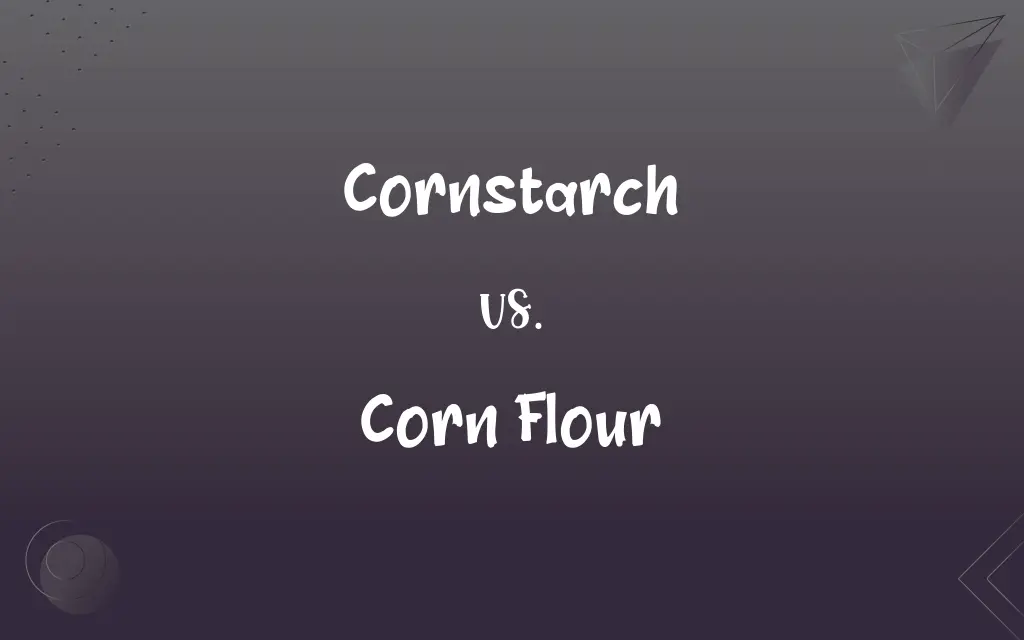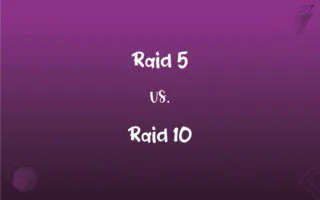Cornstarch vs. Corn Flour: What's the Difference?
Edited by Janet White || By Harlon Moss || Updated on October 17, 2023
Cornstarch is a fine, powdery thickener derived from corn, while corn flour is finely ground cornmeal, used for baking and cooking. Both are corn derivatives but serve different purposes in cooking.

Key Differences
Cornstarch and corn flour, though both originating from corn, are distinct in terms of their texture, usage, and production. Cornstarch is a white, chalky powder and is mainly used as a thickening agent for sauces, gravies, and baked goods. It's produced by pulverizing the starchy center of a corn kernel.
On the other hand, corn flour is essentially finely ground cornmeal. It presents a yellowish hue and has a slightly gritty texture. Corn flour provides more flavor than cornstarch and is commonly used in baking or for making tortillas and cornbread. Its production involves grinding dried corn kernels into a fine or coarse powder.
In the U.S., there's sometimes confusion between the two, as "corn flour" can also refer to what is known elsewhere as "cornstarch." However, in most other regions, including the UK, "corn flour" stands for finely ground corn. For clarity, when reading a recipe, it's essential to understand the context in which either cornstarch or corn flour is mentioned.
Furthermore, the distinction between cornstarch and corn flour lies in their culinary applications. Cornstarch is renowned for its thickening properties, while corn flour is valued for its flavor and baking characteristics. Both are gluten-free, making them suitable for those with gluten sensitivities, but their roles in the kitchen are decidedly different.
Comparison Chart
Texture
Fine, powdery
Finely ground, slightly gritty
ADVERTISEMENT
Color
White
Yellowish
Main Use
Thickening agent
Baking, making tortillas and cornbread
Flavor
Neutral
Corn flavor
Derived from
Starchy center of corn kernel
Ground dried corn kernels
Cornstarch and Corn Flour Definitions
Cornstarch
A gluten-free alternative to flour for some recipes.
For her gluten-intolerant friend, she baked cookies using cornstarch.
ADVERTISEMENT
Corn Flour
A base for some gluten-free recipes.
Corn flour brownies are a hit among her gluten-sensitive friends.
Cornstarch
A fine starch obtained from the endosperm of corn.
Cornstarch puddings have a smooth texture due to their main ingredient.
Corn Flour
A common ingredient in some bread and pancake recipes.
For a twist, he added corn flour to the pancake mix, giving it a unique taste.
Cornstarch
A powdery substance used as a thickener in cooking.
She added cornstarch to the sauce to give it a thicker consistency.
Corn Flour
Sometimes used interchangeably with cornmeal, though finer.
The recipe called for corn flour, but she only had cornmeal, so she ground it finer.
Cornstarch
A common ingredient in Asian cuisine for velveting meat.
The chicken was marinated in soy sauce and cornstarch before frying.
Corn Flour
A yellowish powder with a distinct corn flavor.
The bread had a rich yellow color, thanks to the corn flour.
Cornstarch
A substance sometimes used in DIY crafts and cleaning solutions.
She made a homemade window cleaner using cornstarch, water, and vinegar.
Corn Flour
Finely ground cornmeal, used in baking and cooking.
She used corn flour to make homemade tortillas for dinner.
Cornstarch
Starch prepared from corn grains, used industrially and as a thickener in cooking.
Cornstarch
A very fine starch powder derived from corn (maize) used in cooking as a thickener, to keep things from sticking, or as an anti-caking agent.
Cornstarch
Starch made from Indian corn, esp. a fine white flour used for puddings, etc.
Cornstarch
Starch prepared from the grains of corn; used in cooking as a thickener
FAQs
Can I make corn flour at home?
Yes, by grinding dried corn kernels, you can make corn flour.
How is cornstarch produced?
It's derived from the endosperm of the corn kernel, which is processed and refined.
Why is cornstarch used in Asian cooking for meat?
Cornstarch can "velvet" meat, making it tender and giving it a silky texture.
Why is cornstarch used in baking?
It can provide a finer texture and is also used as a thickening agent.
Can I use corn flour to thicken gravy?
It's possible but might alter the taste and texture compared to cornstarch.
Why is my corn flour yellow but cornstarch white?
Corn flour retains the color of corn, while cornstarch, derived from the endosperm, is white.
How should I store corn flour and cornstarch?
In a cool, dry place, and they can be refrigerated for longer shelf life.
Are cornstarch and corn flour the same thing?
No, cornstarch is a fine thickener, while corn flour is finely ground cornmeal.
Can I substitute cornstarch for corn flour in recipes?
Not always, as they serve different purposes; cornstarch thickens, while corn flour is used for flavor and texture.
Is cornstarch gluten-free?
Yes, both cornstarch and corn flour are gluten-free.
Is there a difference in nutritional value between them?
Yes, corn flour has more fiber and nutrients, while cornstarch is mostly carbohydrates.
Can I use corn flour in place of regular flour?
It depends on the recipe; corn flour has a distinct taste and texture that will affect the final product.
Can I use cornstarch as a direct substitute for all-purpose flour?
Not directly; usually, you'd use half the amount of cornstarch as all-purpose flour when thickening.
Is cornstarch used in cosmetics?
Yes, it's sometimes found in cosmetics due to its smooth texture.
Can corn flour be used to thicken sauces like cornstarch?
While possible, corn flour might alter the flavor and give a grainy texture.
What's the main use of corn flour in cooking?
It's primarily used for baking and making items like tortillas and cornbread.
Do corn flour and cornstarch expire?
Yes, but they have a long shelf life if stored correctly.
What is the difference in calorie content between them?
Cornstarch is almost pure carbs and calories, while corn flour contains some protein and fiber, affecting its calorie content.
Is cornstarch the same as corn flour in the UK?
In the UK, "corn flour" typically refers to what Americans know as "cornstarch."
Is cornstarch good for frying?
Yes, it's often used in batters for a crisp finish.
About Author
Written by
Harlon MossHarlon is a seasoned quality moderator and accomplished content writer for Difference Wiki. An alumnus of the prestigious University of California, he earned his degree in Computer Science. Leveraging his academic background, Harlon brings a meticulous and informed perspective to his work, ensuring content accuracy and excellence.
Edited by
Janet WhiteJanet White has been an esteemed writer and blogger for Difference Wiki. Holding a Master's degree in Science and Medical Journalism from the prestigious Boston University, she has consistently demonstrated her expertise and passion for her field. When she's not immersed in her work, Janet relishes her time exercising, delving into a good book, and cherishing moments with friends and family.







































































